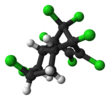| |||
| |||
| Names | |||
|---|---|---|---|
| Systematic IUPAC name
1,2,4,5,6,7,8,8-Octachloro-3a,4,7,7a-tetrahydro-4,7-methanoindane | |||
| Other names
Chlordan; Chlordano; Ortho; Octachloro-4,7-methanohydroindane
| |||
| Identifiers | |||
| ECHA InfoCard | 100.000.317 | ||
| KEGG | |||
PubChem CID
|
|||
| UNII | |||
CompTox Dashboard (EPA)
|
|||
| Properties | |||
| C10H6Cl8 | |||
| Molar mass | 409.76 g·mol−1 | ||
| Appearance | White solid | ||
| Odor | Slightly pungent, chlorine-like | ||
| Density | 1.59 g/cm3 | ||
| Melting point | 102–106 °C (216–223 °F; 375–379 K)[1] | ||
| Boiling point | decomposes[1] | ||
| 0.0001% (20°C)[1] | |||
Refractive index (nD)
|
1.565 | ||
| Hazards | |||
| Occupational safety and health (OHS/OSH): | |||
Main hazards
|
moderately toxic and a suspected human carcinogen | ||
| GHS labelling: | |||
  
| |||
| Danger | |||
| H301, H311, H351, H410 | |||
| P201, P273, P280, P301+P310+P330, P302+P352+P312[2] | |||
| Flash point | 107 °C (225 °F; 380 K) (open cup) | ||
| Explosive limits | 0.7–5% | ||
| Lethal dose or concentration (LD, LC): | |||
LD50 (median dose)
|
590 mg/kg (rat, oral) 100 mg/kg (rabbit, oral) 430 mg/kg (mouse, oral) 300 mg/kg (rabbit, oral) 145 mg/kg (mouse, oral) 1720 mg/kg (hamster, oral) 200 mg/kg (rat, oral)[3] | ||
| NIOSH (US health exposure limits): | |||
PEL (Permissible)
|
TWA 0.5 mg/m3 [skin][1] | ||
REL (Recommended)
|
Ca TWA 0.5 mg/m3 [skin][1] | ||
IDLH (Immediate danger)
|
100 mg/m3[1] | ||
| Safety data sheet (SDS) | Chlordane (technical mixture) | ||
Except where otherwise noted, data are given for materials in their standard state (at 25 °C [77 °F], 100 kPa).
| |||
Chlordane, or chlordan, is an organochlorine compound that was used as a pesticide. It is a white solid. In the United States, chlordane was used for termite-treatment of approximately 30 million homes until it was banned in 1988.[4] Chlordane was banned 10 years earlier for food crops like corn and citrus, and on lawns and domestic gardens.[5]
Like other chlorinated cyclodiene insecticides, chlordane is classified as an organic pollutant hazardous for human health. It is resistant to degradation in the environment and in humans/animals and readily accumulates in lipids (fats) of humans and animals.[6] Exposure to the compound has been linked to cancers, diabetes, and neurological disorders.
- ^ a b c d e f NIOSH Pocket Guide to Chemical Hazards. "#0112". National Institute for Occupational Safety and Health (NIOSH).
- ^ Sigma-Aldrich Co., Chlordane (technical mixture). Retrieved on 2022-03-17.
- ^ "Chlordane". Immediately Dangerous to Life or Health Concentrations (IDLH). National Institute for Occupational Safety and Health (NIOSH).
- ^ Toxicological Profile for Chlordane, U.S. Department Of Health and Human Services, Agency for Toxic Substances and Disease Registry
- ^ Robert L. Metcalf "Insect Control" in Ullmann’s Encyclopedia of Industrial Chemistry, Wiley-VCH, Weinheim, 2002. doi:10.1002/14356007.a14_263
- ^ Agency for Toxic Substances & Disease Registry (ATSDR). Toxic Substances Portal: Chlordane. Last updated September, 2010 [online]. Available at URL: https://wwwn.cdc.gov/TSP/index.aspx?toxid=62



